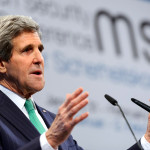Jeffrey Lewis provides a thorough analysis of Benjamin Netanyahu’s graphic aid and theory presented at the 67th UN General Assembly last week and explains why attacking Iran militarily based on the Israeli Prime Minister’s red line is problematic and counterproductive:
…The Prime Minister’s remarks betray a conviction that just as Iran produced a large amount of UF6 enriched up to 5% before starting to use some of it to make UF6 enriched up to 20%, it will in due course start producing UF6 enriched up to 90%. Bibi’s goal comes down to not to getting salami-slicedto weapons-grade uranium, as Joshua would put it. For that purpose, a line simply needs to be drawn at some distinct and recognizable point.
The liabilities of the Netanyahu theory
So what’s the problem? The short version is that committing to use force prior to an Iranian attempt to make weapons-grade uranium is a very dangerous idea. There’s basically no chance that bombing will stop the Iranian nuclear program. But it might spur Iran to take its bomb program off the back burner, speeding up the weapons timetable. As Joshua put ita couple of years back:
It’s often asserted, with an air of worldy maturity and sobriety, that a resort to arms will only provide a few years’ breathing room…. The truth is closer to the opposite.
Here’s how Jeffrey put it recently:
The benefit of a strike is an induced pause in the program — more or less what we have now[,] though imposed through force. The question is whether an airstrike creates more delay than the current indecision of the Supreme Leader. So far, I think, the best answer has been no…
It’s gratifying to see, in Sunday’s New York Times, that this message is finally starting to creep into broader awareness, a mere five years since the 2007 NIE.




